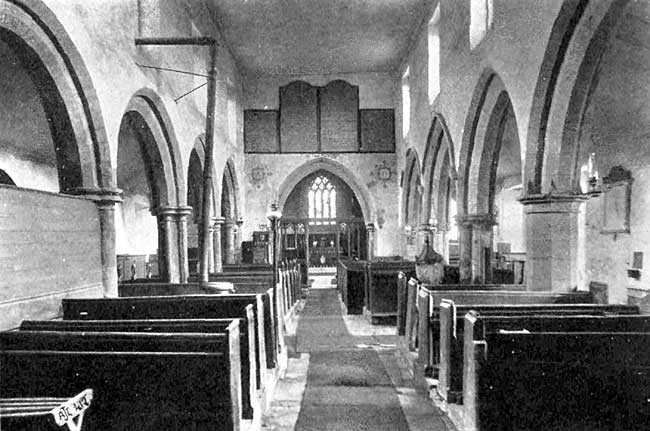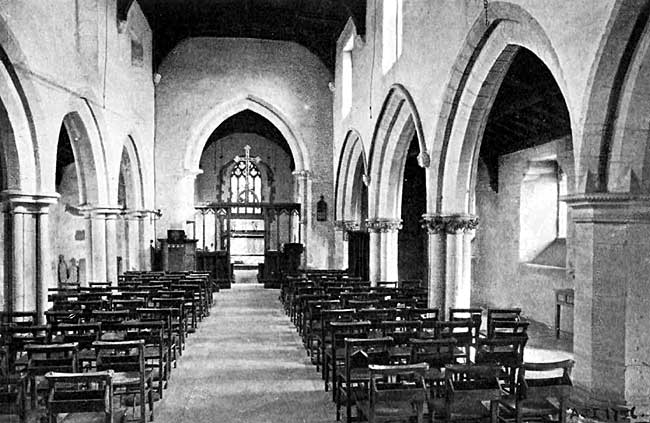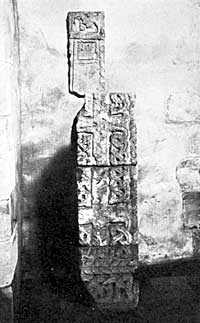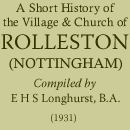Architectural Notes on the Church.

Rolleston Church, about 1894.

Rolleston church, 1931.
The Church is of considerable architectural interest. There is little evidence of the original edifice except the herring-bone masonary in the north wall of the Nave, two small portions of which were left visible when the remainder was re-plastered over during the restoration of the church towards the end of last century; in this case the herring-bone work is probably of Pre-Conquest date.
The side aisles were added in the 13th. century and retain their original width, the arches being formed at all events on the north side, by breaking through the wall without taking it down. The two easternmost bays on the south side are probably the oldest parts of the arcades; both in design and execution they are remarkably fine. The lancet window at the east end of this aisle is no doubt of the same date. An epitaph has been cut on a stone forming part of one of its outer jambs, date 1680. Next in time after these two arches comes the north arcade, and it may be that the two westernmost bays on the south are of about the same date, and that the nave was lengthened one bay westward at the time when the north arcade was built. The single billet ornament in the south-west respond is curious. The small circular windows in the west end of each of the side aisles are about early I4th century work, and are a somewhat peculiar feature.
During the 15th. century new square-headed two-light windows were inserted in the south aisle. The gargoyle now to be seen there on the outside is of the same period but does not belong to its present position.
The 16th. century would see the clerestory added. The height of the nave roof before this addition remains marked on the wall over the Tower Arch.
There is said to have been a private chapel of the Nevills, who formerly held the Manor; if so, this was alongside the easternmost bay of the north aisle. There is no trace now, however, beyond the mark on the inside wall of the aisle where the opening into the chapel ended, and indications of foundations in the course of digging operations in the churchyard.
The chancel arch is 13th. century work, and was formerly lower than at present, the height being increased by three feet in 1895. There is also one lancet window in the chancel of the same date, but this may not be in its original position, as in the following century the chancel was rebuilt and probably lengthened. It was at this time that the square-headed two-light windows in the sides and a pointed four-light window in the east were inserted. The stained glass in this window was inserted in 1878 by William Wright, Esq., in memory of his parents, and that in the lancet window was inserted in 1858 in memory of the Rev. Robert Hodgson Fowler, a former Vicar of the parish. The chancel was the first portion of the church to undergo restoration in the 19th century, when one important alteration was the raising of the roof, which had been flattened, to its original pitch. The chancel floor was one step higher than the nave floor until the latter was unfortunately levelled and made up to the same height. It was at the same time that the ancient stone coffin lids, now to be seen in the side aisles, were there placed. In 1923 the floor of the chancel was repaved to match the centre aisle of the nave, and the walls re-decorated.
The existing chancel screen is much restored, the lower part is of the 15th century, whilst the upper portion is restoration work by Mr. Hodgson Fowler. It seems clear that two altars stood against the chancel screen, and that a parclose ran right across the church cutting off the eastern bay of the nave.
A new cross to replace an old one previously destroyed wantonly was placed on the chancel screen about 1898 by Mr. Hodgson Fowler in memory of his Father and Grandfather, formerly Vicars of the parish.
The south doorway is an interesting specimen of late Norman or Transitional workmanship, being therefore one of the earliest portions of the present building, and would originally be in the wall of the nave before the side aisles were added—it being then re-set in the wall of the aisle. The eastern jamb of this doorway bears what is supposed to be a consecration cross, whilst another stone forming part of the doorway is said to be the remains of a Saxon sundial. Previous to 1895 this doorway was opposite the second bay of the nave, but was moved to its present position when the aisle was restored; care was taken however to carefully number and re-use all the old stones so as to retain their relative positions. The present porch was built at this time, larger and higher than the old one.
The present font dates from about the period of Charles II, the previous one having probably shared the fate which befell many others round Newark during its long siege in the Civil Wars of the 17th century. Previous to the restoration of the nave in 1895, it stood on the south side of the nave, immediately opposite the south doorway.
Of the pulpit there seem to be no records; a perspective drawing by R. H. Fowler, dated 1857, shows it with a carved canopy, but unfortunately this has at some time been removed, before the restoration of the nave, when all the old pews also were swept away and replaced by chairs.
An interesting bowl of a Norman shaft-piscina was found in one of the walls during the restoration, and now stands in a niche in the wall of the south aisle.
The War Memorial, situated on the wall of the south aisle, takes the form of a bronze tablet, and was unveiled by Lieut. G. Wright, of Fiskerton Manor, and dedicated by Dr. Noakes, Archdeacon of Derby, on April 1st, 1921. The design is emblematical of the Resurrection, and gives the names of the men who gave their all for King and Country during the Great War.
THE TOWER. At the very beginning of the 14th. century the tower was built, a broad low structure of two stories only, with thick walls of rubble.
All its belfry windows remain in the walls, but blocked up ; when, however, the tower was restored in 1889, the one in the western face was re-opened so as to be seen outside. In the bottom storey are three curious little single-light windows. During the 15th. century two additional storeys were added regardless of the fact that the old rubble walls were never intended to carry such weight. Certainly, buttresses were added, but these afforded insufficient support, and the ragstone of the lower part gradually decayed and gave way under the pressure, and as a result, in addition to placing the whole of the tower in great peril, thrust the nave arcades out of shape.
The new belfry storey was admirably designed; the peculiar feature is that a pair of belfry windows on each face of the tower, are embraced under a wide ogee hood, which leads up to an intermediate pinnacle in the centre of the battlements, and this on each face being set diagonally, produces a very good effect. All eight pinnacles are of equal height. About 1880 three of the four bells were taken down and the tower shored up with timber at the south-west angle, but the settlement still continued and the condition of the tower became most critical. This shoring cost about £200, and was so much money wasted, as it was found when the work of thorough restoration was taken in hand that the props had shrunk and were not even touching the stonework of the tower.
The work of restoration was carried out in 1889-1890; first the old buttresses were taken down and rebuilt with new and substantial stone in very deep foundations of concrete ; then the entire outer casing of the walls was gradually taken away and replaced with new stone. The tower arch was also taken down and rebuilt, and the old gallery which stretched across the arch was removed. The crown of the tower was repaired where necessary. This restoration cost about £800.
Attention was next directed to the re-hanging of the bells. Three of them were resting in an old pew in the south aisle, and the one in use was very unsafe. The whole of the floors, ladders, frames and other woodwork in the tower was in an advanced state of decay The restoration of this section was carried out in 1892 and the bells again rung, for the first time after many years silence, on Easter Day.
Particulars of the Bells were given in the Parish Magazine for April, 1892, by the Vicar, the Rev. G. D. Wharam.
First Bell. This is the smallest of the four, and weighs about 7^ cwts. It bears the following incription—"GOD SAVE
HIS CHURCH. N.W. (?) W. WARDENS 1697."
Second Bell. This bell weighs about 8^ cwts., and its date is the oldest on the bells. It bears the following inscription— "I sweetly toling men do call to taste on meats that feede the soule 1628."
Third Bell. This bell weighs about 111/2 cwts, and bears the following Latin inscription—" ILLI FECERENT ME IN HONORE TRENITATIS " ("They made me in honour of the Trinity''). Unfortunately it has no date on it, but judging from its appearance and the amount of wear it has had it is thought to be the oldest of the four.
Fourth Bell. This bell weighs 15cwts. 1qr. 11lbs., and bears the following inscription —"ALL YOU THAT HEAR MY
MOURNFULL SOUND REPENT BEFORE YOUR LAYD IX GROUND. ROBT. WISE & ROBT. LONG CHURCH WARDENS THOS. HEDDERLY
FOUNDER NOTTINGHAM 1778." One very interesting feature about this bell is the fact that four coins are inserted in the iron near the crown of the bell. The first coin is a George III shilling; the second is a George II half-crown, and these two show the obverse or head side of the coins. The third coin is a George II crown, dated 1746; the fourth coin is a George II guinea, and these two show the reverse side.
On Nov. 22nd, 1929, a new Screen was placed under the Tower Arch, replacing the former old curtains which did duty for portioning off the Vestry beneath the Tower, and this was dedicated by the Bishop of Southwell, the Right Reverend H. Mosley, D D. The work was carried out by a local craftsman, Robert Lee, of Averham, whose father was responsible for much of the excellent timber-work to be seen in the roof of the church, at its restoration. The carved embellishments of the panels are copied from those on the Chancel Screen.
This, however, was not the last improvement to the church, for on the advent of the Electric Power Supply to the village electric light was installed in the nave by Mr. John Cullen, in commemoration of the long residence of his family in the parish, and in the Chancel by the Ecclesiastical Commissioners, who are Lay Rectors.
The Saxon Inscribed and Ornamented Cross-shaft.
 Saxon Ornamented and Inscribed Cross-shaft.
Saxon Ornamented and Inscribed Cross-shaft.The four fragments of a Saxon stone cross to be seen in the church are of great interest, not only because of their early date, but because, as is most unusual, the name of the presumed maker of the monument is inscribed. These fragments were discovered during the restoration of the church about 1895, and the larger stones stand near the Tower Arch, whilst the fourth, a smaller one which contains the inscription, is built into the wall close above the others ; unfortunately this stone has decayed and the inscription is no longer visible, but photographs and descriptions of it as found are extant. The three larger blocks have at some remote period been taken from the shaft of a cross and re-used as building material, being made to serve as a door-jamb; no doubt the cross would originally stand in the churchyard. These three blocks certainly belong to each other, but quite possibly the smaller inscribed stone belonged to yet another cross. The following is the description as printed in the Reliquary and Illustrated Archaeologist for July, 1897, compiled from particulars supplied by Mr. W. Stevenson, of Hull.
" Fig. I shows the upper part of the shaft and possibly the lower arm of the cross, on which is sculptured what appears to be one of the symbols of the four Evangelists. Probably the Agnus Dei occupied the centre of the cross, and round it on each of the arms may have been the Evangelistic Beasts. At the top of the shaft is a small panel surrounded by a cable moulding containing a neatly cut inscription in mixed Anglo-Saxon capitals and minuscules in two horizontal lines reading:
R A d V L F
V S m e F e
"Radulfus me fe (cit) "
"Radulf made me."
Inscribed crosses of this period are by no means common in England, and it is a great rarity to be told the name of the maker of the monument. The style of the lettering seems to indicate a date not very much before the Norman Conquest, say A.D. 1050 to 1150. Although well acquainted with the early history of the locality. Mr. Stevenson has been unable to identify the Radulf of the inscription.
The remaining three fragments are probably parts of the shaft of the cross. The sculpture on one face only of each remains, that on the other faces having been removed when the stones were reused in medieval times to make the rebated jambs of a doorway."
In "The Crosses of Nottinghamshire " Mr. Stapleton, the author, quoted Mr. Stevenson as follows: "I think the Rolleston cross is older than the inscription leads one to infer, as the panel bearing the inscription is dished or hollowed, as if an older figure or inscription had been rubbed or ground out. It was not uncommon for them to endure to be re-used for later persons than originally intended for. It is of Mansfield stone and as the quarries did not yield large stones the shaft was built up in blocks."
